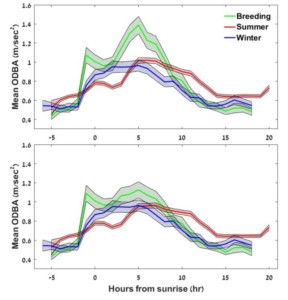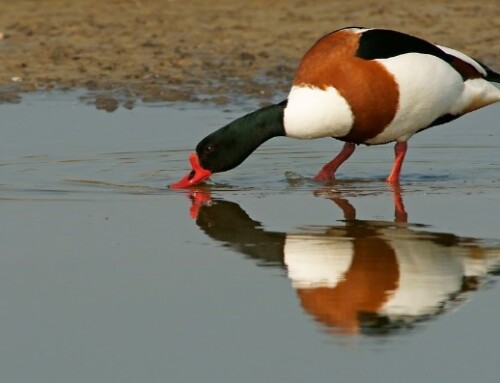LINKED PAPER
Seasonal differences in energy expenditure, flight characteristics and spatial utilization of Dalmatian Pelicans Pelecanus crispus in Greece. Efrat R., Harel R., Alexandrou O., Catsadorakis G. & Nathan R. 2019. IBIS. DOI: 10.1111/ibi.12628. VIEW
Weighing 10 to 13 kg, with a wing span reaching almost 3.2 m, the Dalmatian Pelican, Pelecanus crispus, is one of the largest flying birds in the world. Being large comes with the cost of expending a lot of energy with every wing flap. To minimize their energy expenditure, pelicans and other large birds have evolved a unique flight technique, in which they use their long and wide wings to gain altitude by soaring over rising air currents that keep them airborne. When soaring and gliding, pelicans keep their wings steady and avoid the high energy expenditure of flapping. However, the required rising air currents usually require hot temperatures to heat some of the air and produce hot air columns called thermals.
 Figure 1 The Dalmatian Pelican is one of the largest flying birds on Earth © Francisco Marquez/ The Living Med
Figure 1 The Dalmatian Pelican is one of the largest flying birds on Earth © Francisco Marquez/ The Living Med
Unlike their relative the Great White Pelican, Pelecanus onocrotalus, which migrate to warmer climates in winter, Dalmatian Pelicans only make short movements and stay in mid-latitudes throughout the entire annual cycle. In winter, Dalmatian Pelicans face various challenges. Besides the limited thermals, which rarely occur in winter, and the higher thermoregulation costs of staying in a cold place, pelicans are wet-habitat specialists that feed exclusively off fish, which are harder to find in cold temperatures.
The biggest breeding colony of Dalmatian Pelicans is found in the north-western corner of Greece, at the beautiful Prespa Lakes. Alongside these lakes are some picturesque villages which host a local conservation organization, the Society for the Protection of Prespa (SPP). In their efforts to conserve this species, a collaboration between the SPP and the Movement Ecology Lab (the Hebrew University, Jerusalem) was established to investigate the movement and energy expenditure of Dalmatian Pelicans across the annual cycle.
 Figure 2 The nesting islands of Dalmatian Pelican in Lake Mikri Prespa, Greece, photographed from a drone © O. Alexandrou/SPP Archive
Figure 2 The nesting islands of Dalmatian Pelican in Lake Mikri Prespa, Greece, photographed from a drone © O. Alexandrou/SPP Archive
We used data from transmitters harnessed to pelicans’ backs, which collected both location and acceleration data. Using the GPS data, we analysed the routes taken by the pelicans, including location, timing, speed and altitude. Added to that, we used the acceleration data to see whether the pelicans flapped their wings or soared, and to arrive at an estimation of total energy expenditure.
We found that pelican movement and energy expenditure changed during the annual cycle. Long distance flights between water bodies were more frequent in spring than in other seasons, while in winter the pelicans rarely moved. During spring they mainly visited mainland lakes, including the species’ breeding colonies, while during summer they moved further away, also visiting coastal wetlands in which they eventually stayed for the winter.
The high number of flights during spring was accompanied by higher use of flapping over soaring flight compared with summer flights, probably due to less suitable flight conditions as the air was not hot enough to produce the necessary thermals. On the other hand, the bad atmospheric conditions during winter resulted in reductions in all movements by pelicans, including within the water body they were wintering in. Thus, despite the worse conditions (compared to summer), the pelicans expended more energy during spring, while the conditions in winter made them minimize their energy expenditure (Fig. 3).

Figure 3 Mean hourly overall dynamic body acceleration (ODBA), a proxy for energy expenditure based on movements, including (top) and not including (bottom) long-distance flights
Overall, Dalmatian Pelicans showed flexible behaviour during the annual cycle. We assume that the high movement rate and energy expenditure during spring has to do with social interactions related to the breeding season, while during summer the pelicans move to distant places to locate better feeding conditions. Finally, instead of migrating to warmer places where food is abundant, these pelicans evolved to reduce their energy requirements to a minimum during winter, allowing them to face the less fitting atmospheric conditions that mid-latitudes present for such extremely large, wet-habitat specialists.
Our findings have important conservation implications which can allow season-specific management decisions. Conservation and development plans should consider the different routes that Dalmatian Pelicans use and their movement across the annual cycle, alongside their high sensitivity to energy expenditure during winter. The Dalmatian Pelican is currently considered Near Threatened by the IUCN, following a recent down-listing in their status, which was achieved thanks to ongoing efforts to conserve this species. We call for more ecological and conservation studies focused on the species and for the continuation of efforts to conserve this impressive animal and its habitats.
Nominate this article for a BOU Science Communication Award.
References
Efrat R., Harel R., Alexandrou O., Catsadorakis G. & Nathan R. 2019. Seasonal differences in energy expenditure, flight characteristics and spatial utilization of Dalmatian Pelicans Pelecanus crispus in Greece. IBIS 161: 415-427. VIEW
Image credits
Featured image: Dalmatian Pelican, Pelecanus crispus | Sue Cro | CC BY-NC 2.0




